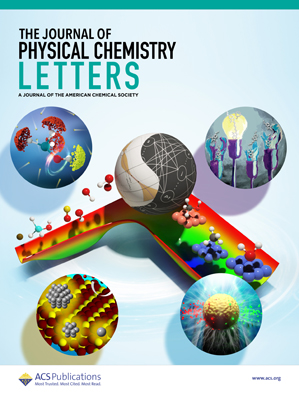利用界面工程控制缺陷WSe2单层的载流子寿命:时域从头算研究
IF 4.6
2区 化学
Q2 CHEMISTRY, PHYSICAL
引用次数: 0
摘要
在有缺陷的过渡金属二硫族化合物(TMDs)单层中,由硫族化合物空位引起的陷阱态对载流子寿命和器件效率都是不利的。为了解决这个问题,化学功能化缺陷TMD单层的表面是至关重要的。硫族化合物空位上的硫醇接枝、氧钝化和电活性分子的物理吸附等实验方法已被用于缺陷修复。我们利用从头算时域密度泛函理论和非绝热分子动力学的研究表明,C20分子吸附和氧钝化有效地减轻了缺陷WSe2的非辐射电子-空穴复合,并提高了缺陷WSe2的载流子寿命,超过了原始WSe2单层。这些改进源于空穴阱辅助过程或自由电子与空穴之间直接相互作用引起的能隙变化、非绝热耦合和退相干时间的综合效应。我们的研究结果表明,修复缺陷tmd中的硫族化物空位可以精确控制电荷载流子寿命,推进二维材料的缺陷工程。本文章由计算机程序翻译,如有差异,请以英文原文为准。

Controlling Charge Carrier Lifetime in Defective WSe2 Monolayer through Interface Engineering: a Time-Domain Ab Initio Study
Trap states induced by chalcogenide vacancies in defective transition metal dichalcogenide (TMDs) monolayers are detrimental to both the charge carrier lifetime and device efficiency. To address this, chemically functionalizing the surface of defective TMD monolayers is crucial. Experimental methods such as thiol grafting on chalcogenide vacancies, oxygen passivation, and the physisorption of electroactive molecules have been explored for defect healing. Our study, using ab initio time-domain density functional theory and nonadiabatic molecular dynamics, shows that C20 molecular adsorption and oxygen passivation effectively mitigate nonradiative electron–hole recombination and enhance carrier charge lifetime in defective WSe2 beyond that of pristine WSe2 monolayers. These improvements stem from the combined effects of energy gap variations, nonadiabatic coupling, and decoherence time, resulting from either hole-trap-assisted processes or direct interactions between free electrons and holes. Our findings suggest that healing chalcogenide vacancies in defective TMDs enables precise control over charge carrier lifetime, advancing defect engineering in 2D materials.
求助全文
通过发布文献求助,成功后即可免费获取论文全文。
去求助
来源期刊

The Journal of Physical Chemistry Letters
CHEMISTRY, PHYSICAL-NANOSCIENCE & NANOTECHNOLOGY
CiteScore
9.60
自引率
7.00%
发文量
1519
审稿时长
1.6 months
期刊介绍:
The Journal of Physical Chemistry (JPC) Letters is devoted to reporting new and original experimental and theoretical basic research of interest to physical chemists, biophysical chemists, chemical physicists, physicists, material scientists, and engineers. An important criterion for acceptance is that the paper reports a significant scientific advance and/or physical insight such that rapid publication is essential. Two issues of JPC Letters are published each month.
 求助内容:
求助内容: 应助结果提醒方式:
应助结果提醒方式:


